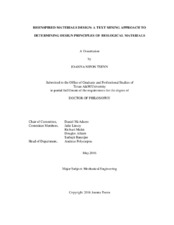| dc.description.abstract | Biological materials are often more efficient and tend to have a wider range and combination of properties than present-day engineered materials. Despite the limited set of components, biological materials are able to achieve great diversity in their material properties by the arrangements of the material components, which form unique structures. The structure-property relationships are known as structural design principles. With the utilization of these design principles, materials designers can develop bioinspired engineered materials with similarly improved effectiveness. While considerable research has been conducted on biological materials, identifying beneficial structural design principles can be time-intensive. To aid materials designers, the research in this dissertation focuses on the development of a text mining algorithm that can quickly identify potential structural design principles of biological materials with respect to a chosen material property or combination of properties.
The development of the text mining tool involves four separate stages. The first stage centers on the creation of a basic information retrieval algorithm to extract passages describing property-specific structural design principles from a corpus of materials journal articles. Although the Stage 1 tool identifies over 90% of the principles (recall), only 32% of the returned passages are relevant (precision). The second stage investigates text classification techniques to refine the program in order to improve precision. The classic techniques of machine learning classifiers, statistical features, and part-of-speech analyses, are evaluated for effectiveness in sorting passages into relevant and irrelevant classes. In the third stage, manual identification of patterns in the returned passages is employed to create a rule-based method. The resulting Stage 3 algorithm’s precision values increase to 45%. In the final stage of algorithm development, the manual rule-based classification method is revisited to identify stricter rules to further emphasize precision. The Stage 4 algorithm successfully improves overall precision to 65% and reduces the number of returned passages by 74%, which allows a materials designer to more quickly identify useful principles. Finally, the research concludes with a validation that the text mining tool effectively identifies structural design principles and that the principles can be used in the development of bioinspired materials. | en |


